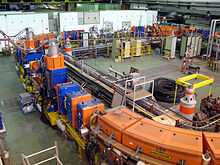Electron cooling

Electron cooler (left) at LEIR/CERN. The electron source and dump are installed in the upper metallic cylinders.
Electron cooling is a method to shrink the size, divergence, and energy spread of charged particle beams without removing particles from the beam. Since the number of particles remains unchanged and the space coordinates and their derivatives (angles) are reduced, this means that the phase space occupied by the stored particles is compressed. It is equivalent to reducing the temperature of the beam. See also stochastic cooling.
The method was invented by Gersh Budker at INP, Novosibirsk, in 1966 for the purpose of increasing luminosity of hadron colliders.[1] It was first tested in 1974 with 68 MeV protons at NAP-M storage ring at INP.
Basically, electron cooling works as follows:
- A beam of dense quasi-monoenergetic electron beam is produced and merged with the ion beam to be cooled.
- The velocity of the electrons is made equal to the average velocity of the ions.
- The ions undergo Coulomb scattering in the electron “gas” and lose energy, which is transferred from the ions to the co-streaming electrons until some thermal equilibrium is attained.
- The electron beam is finally bent away from the ion beam.
See also
References
- ↑ Budker, G. I. (1967). "An effective method of damping particle oscillations in proton and antiproton storage rings". Soviet Atomic Energy 22 (5): 438–440. doi:10.1007/BF01175204.